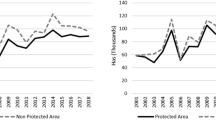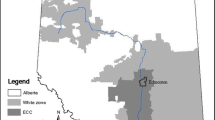Abstract
The effect of expressways on cultivated land is ambiguous. Many studies conclude that building and upgrading expressways increases pressure on cultivated land while others find expressways reduce the rate of cultivated land loss. In this paper, we use satellite remote sensing images of cultivated land in Shandong province of China to test whether the existence of expressway in 2005 affected the level of cultivated land in 2010 and the rate of change from 2005 to 2010. To account for expressway access for each of our 1 \(\hbox {km}^2\) (‘pixel’) units of cultivated land we measure whether or not and what type of roads penetrate the ‘watershed’ in which the pixel lies. These watersheds allow more plausible measures of accessibility than those traditional ‘crowfly’ distance measures that ignore topography. To account for possible confounding we also use 24 additional covariates. Although simple univariate OLS regressions analysis show that cultivated land is always lower while cultivated land increasing rates are higher either when there is an expressway, these results are not robust. Controlling for all of the covariates and also using recently developed covariate matching techniques to estimate treatment effects, we find that expressway can most safely be described as putting a positive impact on cultivated land changes.

Data source: World Development Indicators from World Bank (from 1990 to 2010)




Similar content being viewed by others
Notes
To avoid over-controlling, we do not include in the \(Z_{i}\) matrix of equation. The variable, distance to nearest road, measures the distance from each grid cell to the nearest road of any type. We generated the variable, road density within the watershed by measuring “the length of all roads per square kilometer (\(\hbox {m}/\hbox {km}^{2}\)).
The Moran I statistic is 0.73 for the dependent variable and 0.49 for the residuals. Intuitively, this statistic is equivalent to the slope coefficient of a linear regression of the weighted average value of cultivated cover (residuals) for the pixels surrounding the ith pixel on the cultivated cover (residual) in pixel i.
References
Abadie, A., & Imbens, G. W. (2006). On the failure of the bootstrap for matching estimators. NBER technical working papers 0325.
Anselin, L. (1995). Local indicators of spatial association. Geographical Analysis, 27, 93–115.
Black, D. A., & Smith, J. A. (2004). How robust is the evidence on the effects of college quality? Evidence from matching. Journal of Econometrics, 121(1–2), 99–124.
Bureau of Statistics of Shandong. (2008). China statistical yearbook. Beijing: China Statistics Press.
Chen, Y., Li, X., Tian, Y., et al. (2009). Structural change of agricultural land use intensity and its regional disparity in China. Journal of Geographical Sciences, 19(5), 545.
Chinese National Soil Survey. (2014). National soil information centers from FAO.
Chomitz, K. M., & Gray, D. A. (1996). Roads, land use, and deforestation: A spatial model applied to Belize. World Bank Economic Review, 10(3), 487–512.
Cropper, M., Griffiths, C. W., & Mani, M., (1997). Roads, population pressures, and deforestation in Thailand, 1976–89. World Bank policy research working paper, (1726).
Dehejia, R. H., & Wahba, S. (2002). Propensity score-matching methods for nonexperimental causal studies. The Review of Economics and Statistics, 84(1), 151–161.
Deng, X., Huang, J., Rozelle, S., & Uchida, E. (2006). Cultivated land conversion and potential agricultural productivity in China. Land Use Policy, 23(4), 372–384.
Deng, X., Huang, J., Rozelle, S., Zhang, J., & Li, Z. (2015). Impact of urbanization on cultivated land changes in China. Land Use Policy, 45, 1–7.
Deng, X., Huang, J., Uchida, E., Rozelle, S., & Gibson, J. (2011). Pressure cookers or pressure valves: Do roads lead to deforestation in China? Journal of Environmental Economics and Management, 61(1), 79–94.
Deng, X., Su, H., & Zhan, J. (2008). Integration of multiple data sources to simulate the dynamics of land systems. Sensors, 8, 620–634.
Doll, C. N. H., Muller, J. P., & Elvidge, C. D. (2000). Night-time imagery as a tool for global mapping of socio-economic parameters and greenhouse gas emissions. AMBIO, 29(3), 157–162.
Doll, C. N. H., Muller, J. P., & Morley, J. G. (2006). Mapping regional economic activity from night-time light satellite imagery. Ecological Economics, 57(1), 75–92.
Geist, H. J., & Lambin, E. F. (2001). What drives tropical decultivatedation? LUCC project report series no. 4. International Project Office, University of Louvain, Louvain-la-Neuve.
Gennaio, M. P., Hersperger, A. M., & Bürgi, M. (2009). Containing urban sprawl—Evaluating effectiveness of urban growth boundaries set by the Swiss Land Use Plan. Land Use Policy, 26(2), 224–232.
Gibson, J. (2002). Why does the Engel method work? Food demand, economies of size and household survey methods. Oxford Bulletin of Economics and Statistics, 64(4), 341–359.
Gibson, J., & Olivia, S. (2010). The effect of infrastructure access and quality on non-farm enterprises in rural Indonesia. World Development, 38(5), 717–726.
Gibson, J., & Rozelle, S. (2003). Poverty and access to roads in Papua New Guinea. Economic Development and Cultural Change, 52(1), 159–185.
Hartkamp, A. D., De Beurs, K., Stein, A., & White, J. W. (1999). Interpolation techniques for climate variables. NRG-GIS series 99-01.
Irwin, Elena G., & Geoghegan, Jacqueline. (2001). Theory, data, methods: Developing spatially explicit economic models of land use change. Agriculture, Ecosystems & Environment, 85(1), 7–24.
Jiang, L., Deng, X., & Seto, K. C. (2012). Multi-level modeling of urban expansion and cultivated land conversion for urban hotspot counties in China. Landscape and Urban Planning, 108(2), 131–139.
Jiang, L., Deng, X., & Seto, K. C. (2013). The impact of urban expansion on agricultural land use intensity in China. Land Use Policy, 35, 33–39.
Kok, K. (2004). The role of population in understanding Honduran land use patterns. Journal of Environmental Management, 72, 73–89.
Kravchenko, A., & Bullock, D. G. (1999). A comparative study of interpolation methods for mapping soil properties. Agronomy Journal, 91(3), 393–400.
Kuang, W., Liu, J., Dong, J., et al. (2016). The rapid and massive urban and industrial land expansions in China between 1990 and 2010: A CLUD-based analysis of their trajectories, patterns, and drivers. Landscape and Urban Planning, 145, 21–33.
Laurance, W. F., Sayer, J., & Cassman, K. G. (2014). Agricultural expansion and its impacts on tropical nature. Trends in Ecology & Evolution, 29(2), 107–116.
Liu, J. Y., Liu, M. L., Zhuang, D. F., Zhang, Z. X., & Deng, X. Z. (2003). Study on spatial pattern of land-use change in China during 1995–2000. Science in China D-Earth Sciences, 46(4), 373–384.
Liu, Y., Wnag, L., & Long, H. (2008). Spatio-temporal analysis of land-use conversion in the eastern coastal China during 1996–2005. Journal of Geographical Sciences, 18(3), 274–282.
Liu, J. Y., Zhang, Z. X., Xu, X. L., Kuang, W. H., Zhou, W. C., Zhang, S. W., et al. (2010). Spatial patterns and driving forces of land use change in China during the early 21st century. Journal of Geographical Sciences, 20(4), 483–494.
Long, H., Tang, G., Li, X., & Heilig, G. K. (2007). Socio-economic driving forces of land-use change in Kunshan, the Yangtze River Delta economic area of China. Journal of Environmental Management, 83(3), 351–364.
Long, H., Zou, J., & Liu, Y. (2009). Differentiation of rural development driven by industrialization and urbanization in eastern coastal China. Habitat International, 33(4), 454–462.
Ministry of Public Security of China. (2001). China counties and cities’ population yearbook. Beijing: Chinese Public Security University Press.
NBSC. (2005). Population statistical yearbook for China. National Bureau of Statistics of China.
NBSC. (2010). Population statistical yearbook for China. National Bureau of Statistics of China.
NBSC. (2014). China statistical yearbook. National Bureau of Statistics of China.
NBSC. (2015). China statistical yearbook. National Bureau of Statistics of China.
NBSC. (2001). China social-economic statistical yearbooks for China’s counties and cities. Beijing: China Statistics Press.
NBSC. (2007). China statistical yearbook. Beijing: China Statistics Press.
Pfaff, A. (1998). What drives decultivatedation in the Brazilian Amazon? Evidence from satellite and socioeconomic data. Journal of Environmental Economics and Management, 37, 26–43.
Robalino, J., Pfaff, A., & Sanchez-Azofeifa, G. A. (2007). Estimating spatial interactions in decultivatedation decisions. In A. Kontoleon, U. Pascual, & T. Swanson (Eds.), Frontiers in biodiversity economics. Cambridge: Cambridge University Press.
Sato, Y., & Yamamoto, K. (2005). Population concentration, urbanization, and demographic transition. Journal of Urban Economics, 58(1), 45–61.
Shi, P. (2000). Method and practice of study on land use/land cover changes. Beijing: Science and Technology Press.
Song, M., An, Q., Zhang, W., et al. (2012). Environmental efficiency evaluation based on data envelopment analysis: A review. Renewable and Sustainable Energy Reviews, 16(7), 4465–4469.
Song, M., Zhang, L., An, Q., et al. (2013). Statistical analysis and combination forecasting of environmental efficiency and its influential factors since China entered the WTO: 2002–2010–2012. Journal of Cleaner Production, 42, 42–51.
Tan, M., Li, X., Xie, H., & Lu, C. (2005). Urban land expansion and arable land loss in China–A case study of Beijing–Tianjin–Hebei region. Land Use Policy, 22(3), 187–196.
Tegegne, Y. T., Lindner, M., Fobissie, K., et al. (2016). Evolution of drivers of deforestation and forest degradation in the Congo Basin forests: Exploring possible policy options to address forest loss. Land Use Policy, 51, 312–324.
Turkseven, M., & Ueda, J. (2016). An asymptotically stable pressure observer based on load and displacement sensing for pneumatic actuators with long transmission lines. IEEE/ASME Transactions on Mechatronics, 22, 681–692.
Wang, L., Wang, A., Zhou, D., et al. (2016). An empirical analysis of rural-urban differences in out-of-pocket health expenditures in a low-income society of China. PloS ONE, 11(5), e0154563.
World Bank. (1990–2010). World development indicators.
Xie, Y., & Zhou, X. (2014). Income inequality in today’s China. Proceedings of the National Academy of Sciences, 111(19), 6928–6933.
Acknowledgements
This research was financially supported by the China National Natural Science Funds for Distinguished Young Scholar (Grant No. 71225005), the Key Project of National Natural Science Foundation (Grant No. 71533004) and the National Natural Science Foundation of International/Regional Cooperation and Exchange Programs (Grant No. 71561137002).
Author information
Authors and Affiliations
Corresponding author
Appendix
Appendix
See Fig. 6.
Rights and permissions
About this article
Cite this article
Deng, X., Gibson, J. & Jia, S. Does Expressway Consume More Land of the Agricultural Production Base of Shandong Province?. Comput Econ 52, 1293–1316 (2018). https://doi.org/10.1007/s10614-017-9747-8
Accepted:
Published:
Issue Date:
DOI: https://doi.org/10.1007/s10614-017-9747-8





